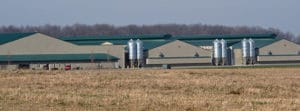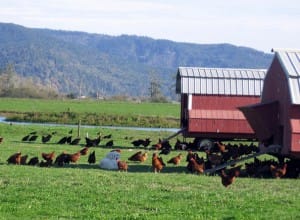Onerous Food Safety Rules Could Abolish Outdoor Access for Laying Hens
Cornucopia, WI – Today, the Food and Drug Administration (FDA) released a draft guidance
document to clarify how egg producers, including organic farmers with
outdoor access, can comply with its 2009 egg safety rule aimed at
reducing salmonella contamination in the nation’s egg supply.Since organic producers are required by federal standards to grant outdoor access to their laying hens, the guidance applies to all organic egg producers. The FDA, which collaborated with the USDA’s National Organic Program in promulgating their guidance, recognizes minute covered porches, which do not afford true and meaningful outdoor access to laying hens, as one of four possible organic production systems and thereby legitimizes their use.

Already the focus of controversy and threatened lawsuits, the USDA has been widely criticized for allowing giant “organic” factory farms, confining as many as 100,000 birds to a building, to skirt the requirements for outdoor access by employing tiny screened porches, often with a capacity of only 1-3% of the confined birds. The USDA is currently allowing these giant poultry operations to claim these structures as the legally required “access to the outdoors.”
“This is collusion between two Obama administration agencies to significantly and permanently weaken the integrity of the organic standards,” says Mark Kastel, Codirector of The Cornucopia Institute.
“By giving the OK to use covered porches as ‘outdoor access,’ and putting additional burdens on producers with legitimate outdoor runs or pasture, the recommendations in this food safety document decisively tilt the playing field to industrial-scale producers,” added Kastel.
Some in the organic community had been concerned that the FDA would require impractical swabbing and disinfecting of the outdoor areas but the draft guidance puts these concerns to rest. However, other prevention and control measures that are included in the guidance could force organic producers to devote significant additional resources, or may even make it impossible for pastured poultry operations to comply.

Stephanie Alexandre, a producer of certified organic, pastured eggs near Crescent City, California, objects to the draft guidance. “It’s ironic that federal regulators would apply such scrutiny, and costly and labor-intensive requirements, to my farm when there is abundant published, peer-reviewed research indicating that the real danger to society, from salmonella contamination in eggs, comes from giant industrial operations, generally with caged birds, not with modest sized flocks of pastured poultry,” said the organic farmer.
For example, despite weak scientific evidence that contact with wild birds is a significant risk factor for salmonella contamination, the FDA requires organic producers to minimize contact with other birds. The agency recommends noise cannons, temporary confinement, or netting, or even structures with roofs (porches) which would be cost prohibitive for most organic producers with meaningful outdoor access.
Read More Here
Related articles













No comments:
Post a Comment
Hello and thank you for visiting my blog. Please share your thoughts and leave a comment :)